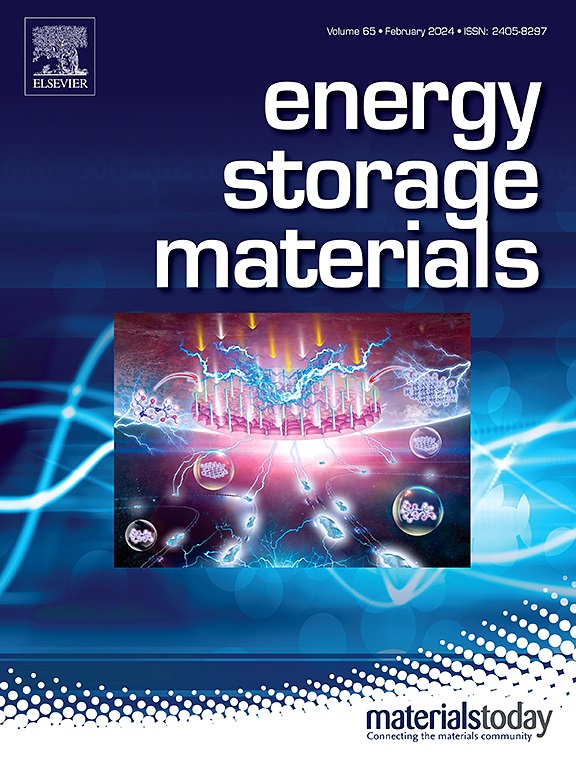低温电池电解液工程中以氟为主的亚硫酸二甲酯的定制电解溶剂化
IF 20.2
1区 材料科学
Q1 CHEMISTRY, PHYSICAL
引用次数: 0
摘要
碳酸盐电解质是低温锂金属电池(lt - lmb)发展的主要决定因素。然而,传统的溶剂主导型碳酸乙酯电解质在低温条件下存在反应动力学缓慢、界面副反应严重、Li+脱溶能高的问题。本文设计了一种由LiDFOB和亚硫酸二甲酯(DMS)、三氟乙酸乙酯(ETFA)和氟乙烯碳酸酯(FEC)等混合溶剂组成的无ec弱溶剂化电解质,以促进反应动力学并稳定lt - lmb的界面,在设计的电解质中形成了富氟化结构,包括FEC、ETFA和DFOB-。通过在电极表面形成高离子导电性和富含无机物的保护膜,这种溶剂化配置可以显著促进溶剂化过程,诱导均匀的Li沉积。使用这种电解质,Li||NCM811电池在1000次循环后仍保持81.7%的高容量保持率,远远优于ec基电解质的31.3%。即使在-40°C下,电池也显示出125.7 mAh g-1的容量,在200次循环后几乎没有容量衰减。本研究证实了氟化物占主导的溶剂化结构在降低脱溶能和加速离子转移方面的必要性,为低温lmb的发展提供了一个有希望的解决方案。本文章由计算机程序翻译,如有差异,请以英文原文为准。
Tailoring electrolyte solvation of dimethyl sulfite with fluoride dominant via electrolyte engineering for enabling low-temperature batteries
Carbonate electrolytes are the primary determinant for the development of low-temperate lithium metal batteries (LT-LMBs). However, conventional ethyl carbonate (EC)-based electrolytes with solvent-dominated solvation configuration suffer from sluggish reaction kinetics, severe interfacial side reactions and high Li+ desolvation energy under low temperature. Herein, an EC-free and weakly solvated electrolyte consisting of LiDFOB and mixed solvents including dimethyl sulfite (DMS), ethyl trifluoroacetate (ETFA) and fluoroethylene carbonate (FEC) was designed to facilitate the reaction kinetics and stabilize the interfaces of LT-LMBs, where a fluoride-rich solvation structure including FEC, ETFA and DFOB- is formed in the designed electrolyte. Such solvation configuration could significantly facilitate the desolvation process and induce the homogeneous Li deposition by forming high ionic conductive and inorganics-rich protective film on the electrode surfaces. With such electrolyte, the Li||NCM811 cell retains a high capacity retention of 81.7% after 1000 cycles, which is far superior to the 31.3% for EC-based electrolyte. Even at −40°C, the cell exhibits a capacity of 125.7 mAh g-1 with almost no capacity attenuation after 200 cycles. This work confirms the necessity of fluoride-dominated solvation structure in decreasing the desolvation energy and accelerating the ionic transfer, contributing a promising solution to the development of low-temperature LMBs.
求助全文
通过发布文献求助,成功后即可免费获取论文全文。
去求助
来源期刊

Energy Storage Materials
Materials Science-General Materials Science
CiteScore
33.00
自引率
5.90%
发文量
652
审稿时长
27 days
期刊介绍:
Energy Storage Materials is a global interdisciplinary journal dedicated to sharing scientific and technological advancements in materials and devices for advanced energy storage and related energy conversion, such as in metal-O2 batteries. The journal features comprehensive research articles, including full papers and short communications, as well as authoritative feature articles and reviews by leading experts in the field.
Energy Storage Materials covers a wide range of topics, including the synthesis, fabrication, structure, properties, performance, and technological applications of energy storage materials. Additionally, the journal explores strategies, policies, and developments in the field of energy storage materials and devices for sustainable energy.
Published papers are selected based on their scientific and technological significance, their ability to provide valuable new knowledge, and their relevance to the international research community.
 求助内容:
求助内容: 应助结果提醒方式:
应助结果提醒方式:


